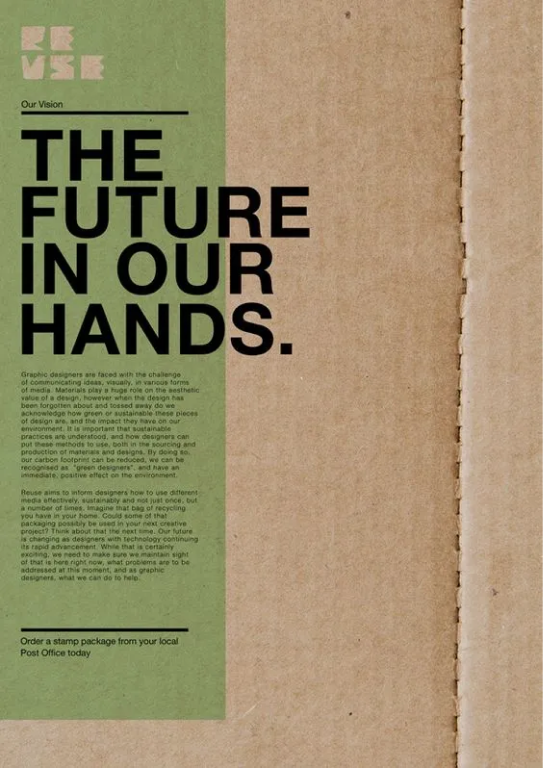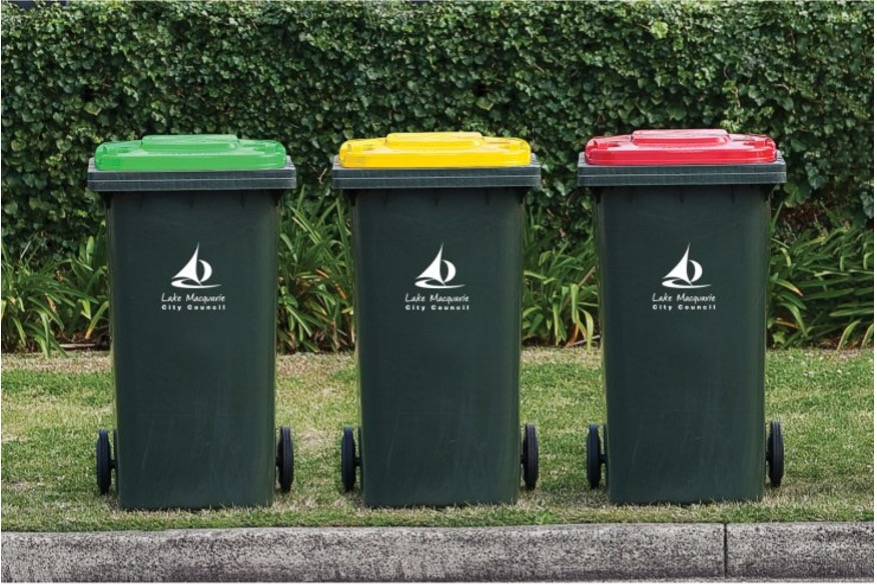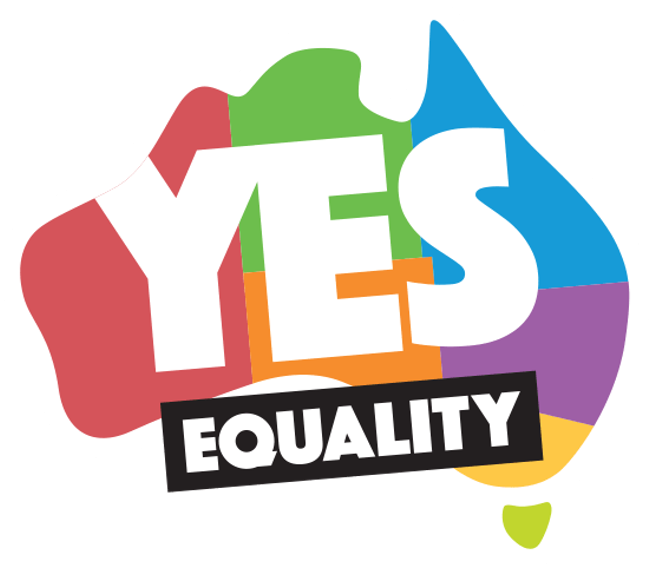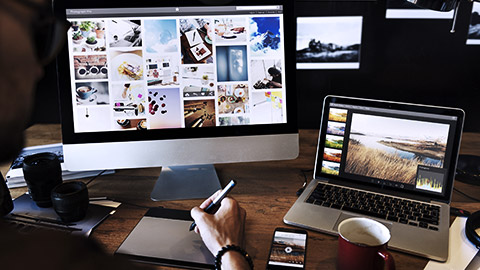Welcome to topic 6 – Develop Response to Changing Trends & Technologies. The purpose of this topic is to allow you to identify and use research, critical and analytical thinking, and networking strategies to develop your own approach to industry opportunities, trends, and changes.
You will be introduced to the following topics:
- Compare graphic design trends to own graphic design work
- Analyse creative or commercial opportunities presented by emerging trends
- Use networking and professional development opportunities
- Identify and respond to industry trends, and
- Refine your approaches to your own work in response to current and emerging trends.
Comparing graphic design trend to your own graphic work can be quite a convoluted process. Trends help shape the development and evolution of graphic design as a creative discipline, opening new doors of creative possibility and providing new tools with which to meet design challenges. Graphic designers draw inspiration from all creative fields including other fields of design, such as furniture and interiors. Indeed, many creative people do not see themselves as being limited to one discipline.
In 2023, sustainability is likely to be a major trend in the world of graphic design. With growing awareness of the environmental impact of consumer goods and packaging, many brands are looking for ways to reduce their carbon footprint and use sustainable materials in their work. With a renewed focus on practical solutions that can help reduce the design’s environmental impact. This trend will likely manifest by using biodegradable and environmentally friendly materials in packaging and other physical brand experiences. Examples of this trend can already be seen in the work of companies like Kellogg’s, which has the smallest plastic footprints. The company is currently using recycled cardboard and overall, 76% of their packaging is recyclable. They aim to make 100% of packing either recyclable or compostable by the end of 2025.

Sustainable graphic design prioritises the impact the design has on the environment. From the beginning until the end. This includes the impact of raw materials, manufacturing, transportation, and disposal. Graphic design can either be on paper or digital. For each of these, there are different things to consider making the design green. General digital graphic design has a much lesser impact on the planet. However, that should not deter anyone from printing designs on paper or products. Both can be sustainable. You will need is to change your habits and become more aware of the environmental issues of graphic design.
Sustainable graphic design is not just design that helps people and our planet, but design that is also critical of existing social, cultural, technical, AND economic structures; since many of these things are harming all life, not helping them to flourish. We judge graphic design on whether it is formally “good.” With recycling already on people’s radar – each home has a green bin for garden and kitchen refuse, and a yellow bin for cardboard and plastic items, the connection between sustainable trends in design is obvious.

Image from Sydney Morning Herald
People are increasingly paying attention to environmental issues and causes. As consumers’ concern about the earth grows, their appreciation for natural patterns and textures will grow as well. It’s no longer enough to simply add or integrate green into designs to hint at sustainability. To win the favour of eco-conscious customers, brands need to show their commitment to the environment through creative and original content in their designs. Nature-inspired visuals resonate with audience interests in the natural world, organic materials, conservation, and sustainability. Images of flowers and plants, wood textures and blue skies, and animal patterns like leopard and zebra prints are all popular nature motifs. Additionally, DIY styles, printed paper, and watercolour are becoming more in vogue for regular people and professional designers alike.26
The idea of representation and belonging covers gender, race, culture, ability, and accessibility. Also referred to as diversity, equity, and inclusion, this is increasingly about more than just showing or claiming representation but engendering true feelings of belonging — welcoming different groups and communities and creating space for them.
The push for greater representation and belonging extends far beyond the world of design, but within it, there is an increasing emphasis on depicting people of different ethnicities, genders, sexualities, ages, and abilities. In addition, the industry is starting to shift to a more representative talent pool and hiring with diversity in mind. But inclusivity also applies to the function of design — creating designs with accessibility in mind.

Image sourced from Vote Yes
Australia said YES to marriage equality in 2017 with the video on the Vote YES campaign.
Graphic design is subject to the evolving intellectual and aesthetic trends that influence the work of designers and reflect the attitudes of society at large. Designers may work with, and choose from, a varied selection of sources to conceive the final design – whether employing a philosophical viewpoint, such as modernism, or relying on pure aesthetics of current trends in typeface design or fashion, for example.
It is the individual designer’s responsibility to decide what their views are and where their priorities lie. Ultimately, such personal debates are often tempered by the fact that as an employee within a commercial design practice, a designer has a contractual responsibility to perform the tasks asked of them. It is the 21st century, and most things appear to be changing at an alarming rate. Technology is one of the hardest topics to ignore due to its influence on significant aspects of our lives. Its effect on graphic design is quite significant following the major transitions from the old designing methods of using paints and typewriters to trends such as Adobe Photoshop and Autodesk Maya. Just like any other changes, the technological changes in graphic design have stirred mixed reactions among most designers.
Graphic design is being advanced on all fronts by technology. It is unquestionably not what it was in the 1990s. As new technologies are introduced, the field will only continue to change. The creative aspect of graphic design has remained constant throughout, and these trends merely make the job easier for graphic designers rather than taking away from their abilities or originality.
Even the most advanced technologies are nothing without great design. Experience design plays a vital role in the successful creation and adoption of emerging technology, and at the same time, emerging technologies are the next great frontier for user experience. Many common design language decisions related to emerging technology are yet to be clearly defined.
Watch
Watch this video on 5 reasons why graphic design is important for any business.
Using networking and professional development opportunities to identify and respond to industry trends is an established process. Graphic designers build up a client base through reputation, networking, and word-of-mouth. Emerging graphic designers, on the other hand, are reliant on self-promotion. Successful self-promotion starts with undertaking adequate research about a client or agency; a designer must find out as much as possible regarding the nature of their prospective client’s business and the key contacts within the company.
First impressions count for a lot, so ensure that all information is correct – the names of the people holding your future earning potential in their hands must be spelled correctly on any communication. Once your material has been sent, whether by email or post, always make a follow-up call. Websites and online social media platforms have become an integral visual communication tool for designers and design studios alike. They showcase work to other studios and prospective clients, while also providing inspiration.27
Business cards are a great way to introduce yourself. If you know a person or company you’d like to reach out to, business cards are a great ice breaker. They can be handed out in person or accompanied by a note sent in the mail. A business card makes you look professional and provides all the information recipients need to find out more about you. In today’s digital world. It is easy to assume business cards have fallen out of favour, but this couldn’t be further from the truth. First impressions count. The same way you dress up for an interview, your business card should dress up too. It’s not just about the design either. Think about the words, the weight, and the feel.

Networking is not as overwhelming as it might sound. When you hang out with friends at a coffee shop or bar, you are networking. When you have dinner with relatives from out of town, you are networking. Networking is simply a support system of sharing information (or services) among individuals and groups who have a common interest. Creative professionals get uncomfortable thinking about “networking events” because they have the wrong view of it. Networking should not be something full of pressure. No one is anxious about hanging out with their friends over dinner, they’re just there and you talk and get to know each other. Professional networking should be no different.
Networking is just hanging out with people you already have something in common with and getting to know each other. Creatives can sometimes be kind of self-centred. Because a lot of us work on our own or for ourselves, we look at most things we do through the lens of “how will this benefit me or my skills?”. We think about how someone will help us get better connections, or what will we learn, etc. Networking easily and quickly becomes all about us. Start thinking about what you have in a group of people that you could share, instead of looking around at what you can get.
Because creatives are naturally introspective, we don’t always realise that we are being a little greedy when it comes to our thinking. We honestly are just always trying to be better and learn more to be awesome at what we do. The true secret though, is that by sharing with others, we will become better because others will want to share with us. Shared knowledge through networking is a powerful tool.28
Watch
Watch this video on networking for designers.
Staying up on trends in the creative space is hugely important, for design professionals. Think about it this way: if you’re a mechanic, but you aren’t keeping in touch with new technology that makes your work better and faster, then you aren’t going to be that effective. It’s the same for design—keeping current with the latest design language, styles, and typographic systems will keep your projects relevant and your work powerful. When weaving a design trend into your work, it’s important not to just parrot back that trend at face value. But you can use the smaller components of a trend to build your own work.
The best starting place is to look at the designers and brands that you follow and take note of what inspires you. Then, really try to get down to what the essence is of that piece of art. Why does it inspire you? Once you understand that, then you’re using something deeper as your starting point, allowing you to put your own spin on it. The concept of boiling down a trend’s essence is important for platforms like social media, because while most brands are just taking the trends at face value, you could take that trend and really make it your own. This allows you to harness the power of that trend, while also standing out in an otherwise saturated market.

If something is a trend, it doesn’t mean it’s a positive thing. A trend is something that’s often short-lived, fleeting, and not timeless - many of them are reactions. When something hits a tipping point, the trend becomes oversaturated, and the market responds by reversing it. The point here goes back to the first recommendation above—try to follow brands and designers that are personally interesting to you, not just following trends you see everywhere.29
The graphic design industry relies on a constant churn of novel ideas. It is not enough just to learn and relearn design software, which comes out every year or so. Those are just your tools. You also must refine your aesthetic again and again, to keep up with the latest graphic design industry trends. A lot of designers know and do this but is it good enough? Every graphic designer thinks it does—at first. But as you learn more about the field, you will see what all outstanding graphic designers know: keeping up with trends in graphic design is a job by itself. The longer you’ve been a designer, the more time you’ve had to create your own signature style. You know what you’re doing and how you want to do it. Because of that, sometimes we are apt to do the things we’re comfortable with and not as willing to take risks.
When you first break into the industry, you’re eager to prove yourself. One of the drawbacks of working for a corporation is that they tend to already have standards and guidelines in place. If you don’t follow them to a “T,” then you risk getting in trouble. While they do want your work on trend, they also don’t want to think too far outside the box of what they know works for the majority of their clients or their business model.
In today’s ever-changing world, graphic designers may find it difficult to keep themselves up to date with the newest design trends. Thanks to technological advancements happening at lightning-fast speed, software that graphic designers use daily constantly evolves. As a result, this affects the tools that graphic design professionals utilize and the visual appearance of their completed artworks. Rather than focus on a typical routine, it’s essential for graphic designers to keep their eyes open to the latest styles and experiment with new design treatments to stay a step ahead of the industry.
You have a wealth of graphic design resources right at your fingertips on the Internet to stay current on new developments in design. Start surfing through cyberspace to find quality blogs, RSS feeds, social media profiles, and news outlets that are sharing information about graphic design and follow them. Look for design galleries that are showcasing creative graphic designs created by designers like you. DeviantArt, Behance, Raster, and Delicious CSS are all great websites that every graphic designer should look at. You may also want to join in on the action by joining design forums, commenting on blogs, and sharing your opinion in online discussions. You’ll likely receive plenty of feedback that can revolutionise your ideas and help you stay ahead of the design curve.
